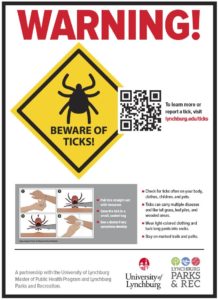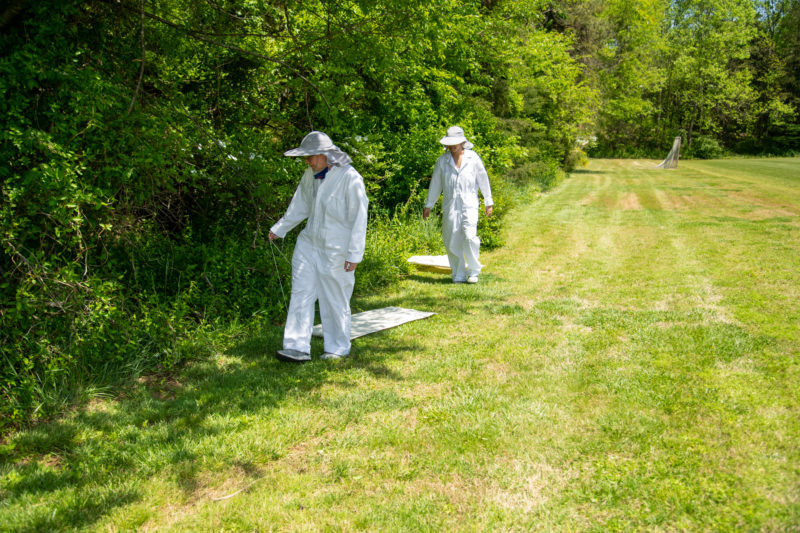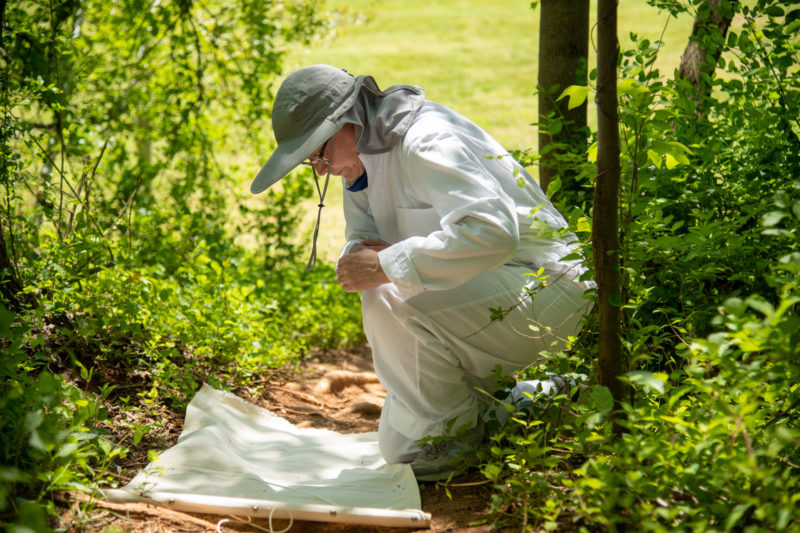The University of Lynchburg’s Master of Public Health program has partnered with the city of Lynchburg’s parks and recreation department on a project aimed at helping area residents stay safe from tick-borne diseases.
Educational signs will soon be posted at local community centers and parks and along the city’s Blackwater Creek Trail system, which extends onto campus. On campus, signs also will be posted at trailheads, near the disc golf and ropes courses, and on practice athletic fields.
 The signs were developed by Dr. Jenny Hall, associate professor in the MPH program, and designed by University Communications and Marketing. University physical plant employees will install the signs on campus. Lynchburg Parks and Recreation will handle installation in city-managed areas.
The signs were developed by Dr. Jenny Hall, associate professor in the MPH program, and designed by University Communications and Marketing. University physical plant employees will install the signs on campus. Lynchburg Parks and Recreation will handle installation in city-managed areas.
“We have worked together to create permanent signage for our trail system and many facilities that will provide information for all citizens about the danger these pests pose,” Chris Higgins, the city’s park services manager, said.
“Working with experts like the University’s staff and students is an amazing opportunity that helps our department provide up-to-date information that may not otherwise be available.”
In addition to providing information about ticks, the signs have a QR code that takes people to a new University webpage. The page includes more detailed information about the types of ticks common in the area; tick-borne diseases, like Lyme, alpha-gal allergy, and others; what to do if you’re bitten; and how to protect yourself and your family from ticks.
“Just knowing how many of these ticks are out there and how debilitating tick-borne diseases are for some people, I felt we needed to get the signage up and prevent more people from potentially getting sick,” Hall said.
The signage project is an extension of research that began in October 2019, when MPH students and faculty started “tick dragging” in an effort to learn more about the area’s tick population. As one might imagine, the activity involves using a cloth to pick up ticks that are hiding in vegetation.

Since then, student and faculty researchers have hunted — and captured — ticks on campus and off. In early June, Hall and four MPH students found 42 ticks along the University’s trails in just over an hour. They also have dragged along trails at Peaks View Park, a popular city park.
“We were finding a lot of ticks everywhere, particularly where people might recreate, near benches, right off the main trails, and practice soccer fields where balls might go in the woods,” Hall said.
One of Hall’s students, Judi Muir ’21 MPH, plans to combine the tick research with what she learned in Applied Geography, an environmental science class she took at Lynchburg. “I hope to use the data from the tick drags, identification, and molecular mapping of tick-borne disease to make GIS maps of local trails using ArcGIS software,” she said.
Muir, a former biology and pharmacology teacher, added, “I have a science background, so the project interests me as it is something different for me. And tick-borne illness is on the rise, so it is a key area to research in public health.”
Hall is also surveying and interviewing people diagnosed with tick-borne illnesses and collecting data. Other plans include partnering with Lynchburg’s biology program to test the ticks, and distributing tick collection kits to the public, so they can contribute to the research, too.

Hundreds of tick removal kits will also be distributed. Each kit will include a travel pouch with disposable tweezers, a zip-lock baggie for saving the tick, instructions on how to properly remove the tick, and alcohol swabs to clean the area.
“The plan is to go out to Peaks View and other trailheads a couple of times in July and do outreach to educate the public,” Hall said, adding that June and July “tend to be the highest months” for ticks and tick bites.
Hall said her “dream and hope” is to create an interdisciplinary center on campus dedicated to tick-borne disease and research. The center would bring together not only MPH students and faculty, but also students and faculty from the biology, environmental sciences, Westover Honors College, health promotion, and physician assistant programs.
“Having a research and education center dedicated to ticks and tick-borne diseases would strengthen collaborations among different faculty and academic programs, expand faculty-student research and outreach opportunities, and lead to increased external funding opportunities for the University,” Hall said.
It also will benefit the community at large. “[It] would provide the community and public with a local and regional resource on research and education related to ticks and tick-borne diseases,” Hall said.
“The center would provide a variety of education and outreach resources … designed and implemented for the community to help with issues related to prevention, diagnosis, management, and treatment of tick-borne diseases, particularly those most common to the Central Virginia region.”

